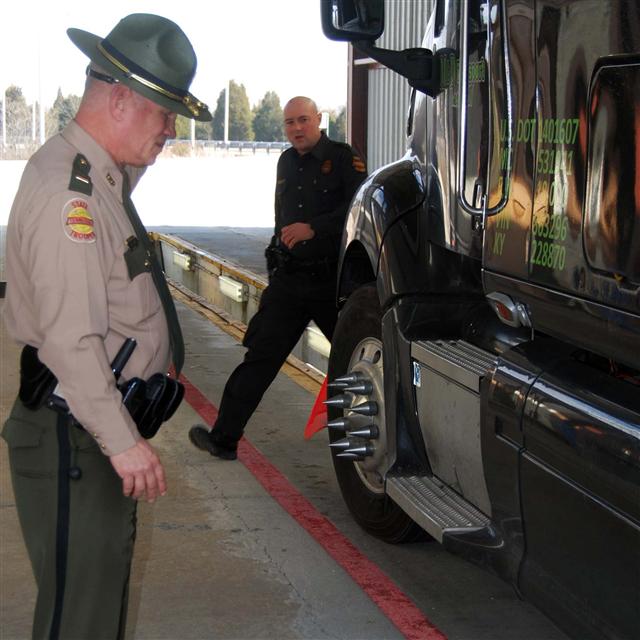The Required Official Inspection Procedure, as approved by the Virginia State Police Superintendent, is as follows:
REQUIRED OFFICIAL INSPECTION PROCEDURE
Each inspection consists of the following items – for further details consult the “Official Inspection Manual”:
1. – REMOVE OLD INSPECTION STICKER.
2. – DRIVE VEHICLE INTO INSPECTION LANE.
3. – INSPECT BRAKES FOR:
- Worn, damaged or missing parts.
- Worn, contaminated or defective linings or drums.
- Leaks in system, proper fluid level.
- Worn, contaminated or defective disc pads or discs.
(NOTE: A minimum of two wheels and drums must be removed from each vehicle at the time of inspection. Consult the official inspection manual for exceptions.)
4. – INSPECT PARKING BRAKE FOR:
- Broken or missing parts.
- Proper adjustment.
- Standard factory equipment or equivalent.
5. – INSPECT HEADLIGHTS FOR:
- Approved type, aim, and output.
- Condition of lamp, wiring and switch.
- Beam indicator.
6. – INSPECT OTHER LIGHTS FOR:
- Approved type, proper bulbs, condition of lenses, wiring and switch.
- Aim of fog and driving lamps.
- Illumination of all lamps, lens color, and condition of lens.
(NOTE: Every vehicle must have a rear lamp showing a red light to the rear, a white light illuminating the rear license plate; vehicles over 7 feet wide or extending 4 inches or more beyond the front fender extremes must be equipped with approved clearance lamps and reflex reflectors. Count load in measuring.)
7. – INSPECT SIGNAL DEVICE FOR:
- Approved type, proper bulbs, condition of lenses, wiring and switch.
- Correct indications and tell-tale (visual or audible).
- Illumination of all lamps, lens color, and condition of lens.
8. – INSPECT STEERING & SUSPENSION FOR: (Jack up front end as shown in Manual)
- Wear in bushings, kingpins, ball joints, wheel bearings, tie rod ends.
- Looseness of gear box on frame, condition of drag link and steering arm.
- Play in steering wheel.
- Wheel alignment and axle alignment.
- Broken spring leaves, and worn shackles.
- Shock absorbers.
- Broken frame.
- Broken or missing engine mounts.
- Lift blocks.
9. – INSPECT TIRES, WHEELS & RIMS FOR:
- Condition of tires including tread depth.
- Mixing radials and bias ply tires.
- Wheels that are cracked or damaged so as to affect safe operation.
10. – INSPECT MIRROR FOR:
- Rigidity of mounting.
- Condition of reflecting surface.
- View of road to rear (Truck mirrors must extend at least halfway beyond edge of body) – (Visibility 200 feet to rear).
11. – INSPECT HORN FOR:
- Electrical connections, mounting and horn button.
- Emits sound audible for a minimum of 200 feet.
12. – INSPECT WINDSHIELD AND OTHER GLASS FOR:
- Approved type safety glass.
- Cloudiness, distortion or other obstruction to vision.
- Cracked, scratched or broken glass.
- Stickers. ALL UNAUTHORIZED STICKERS MUST BE REMOVED.
- Sunshading material attached to the windshield to ensure it does not extend more than 3 inches downward from the top of windshield, unless authorized by Medical Waiver Certificate.
- Operation of left front door glass.
13. – INSPECT WINDSHIELD WIPER/DEFROSTER FOR:
- Operating condition.
- Condition of blade.
14. – INSPECT EXHAUST SYSTEM FOR:
- Exhaust line-manifold, gaskets, pipes, mufflers, connections, etc.
- Leakage of gases at any point from motor to point discharged from system.
15. – INSPECT LICENSE TAGS FOR:
- Illumination of rear plate.
16. – INSPECT HOOD AND AREA UNDER THE HOOD FOR:
- Operating condition of hood latch.
- Presence of emissions system -Evidence that any essential parts have been removed, rendered inoperative or disconnected.
- Fluid levels that are below the proper level
1. Brake fluid.
2. Power steering fluid.
- Power steering belt – proper tension, wear, or absence.
17. – INSPECT AIR POLLUTION CONTROL SYSTEM (1973 and Subsequent Models) FOR:
- Installation.
- Operation.
(NOTE: This includes the catalytic converter and the fuel tank filler pipe.)
18. – INSPECT DRIVER’S SEAT FOR:
- Anchorage.
- Location.
- Condition.
19. – INSPECT SEAT BELTS FOR:
- Approved type.
- Installation.
20. – INSPECT AIR BAG AND AIRBAG READINESS LIGHT FOR:
- Any defects in the air bag system noted by the air bag readiness light, or otherwise indicated; or
- The air bag has been deployed and has not been replaced (and is not deactivated because of a medical or other exemption and a notice is posted to indicate that it has been deactivated); or
- Any part of the air bag system has been removed from the vehicle; or
- If the air bag indicator fails to light, or stays on continuously.
21. – INSPECT DOORS AT THE RIGHT & LEFT SIDE OF THE DRIVER’S SEAT FOR:
- Handle or opening device which will permit the opening of the door from the outside and inside of the vehicle.
- Latching system which will hold door in its proper closed position.
22. – INSPECT FUEL SYSTEM FOR:
- Any part that is not securely fastened.
- Liquid fuel leakage.
- Fuel tank filler cap for presence.
23. – INSPECT FLOOR PAN FOR:
(a) Holes which allow exhaust gases to enter occupant compartment.
(b) Conditions which create a hazard to the occupants.
24. – ISSUE STICKER:
(a) If approved, place approval sticker on the vehicle, and give pink copy of certificate to operator.
(b) ALL DEFECTS MUST BE CORRECTED AND THE VEHICLE REINSPECTED WITHIN 15 DAYS.
THE DRIVER MAY BE IN JEOPARDY OF RECEIVING A SUMMONS FOR ANY DEFECT STILL
PRESENT ANY TIME THE VEHICLE IS OPERATED ON THE HIGHWAY.
(NOTE: The validity period of the rejection sticker shall include fifteen (15) days in addition to the day of the inspection.)
